About the Wessex Morris Men
Wessex Morris Men
Wessex Morris Men were founded in 1957 by a group of young men out of The White Horse Morris Men. We are
an all male side, dancing mainly in the Cotswold tradition. The side is an active member of the Morris Ring.
We dance out, mainly from St. George's day and in the summer months, around West
Dorset and nearby. During the summer we dance on Monday evenings (see our
programme
for details). We also dance at shows, fetes and other public and private
events. If you would like to book us, or would like to join us, see our
contact page.
We are an international side and have in previous years visited Poland,
Germany, France, Austria Channel Islands, Southern Ireland and even the darkest,
remotest parts of Dorset (passport essential). We also visit other sides
within the UK and try where we can to attend their Ales and Ring meetings.
Recent events we have been involved in include the Hartley Ale in
Summer 2015, where a fantastic time was had by all.
Working with the
Douzelage (a twinning group of towns, based, in this country, in Sherborne)
we have visited a number of European towns, there being one town in each of most
countries in the EEC. We generally make a foreign visit each year.
In October 2015,for example, this was to Bundoran in Southern Ireland.

During our closed season (September to April) we practise at Pulham Village
Hall on Mondays between 8:00 pm and about 10:00 pm. We then cross the road to the Halsey Arms for a music and social session.
Over the years, Wessex Morris Men have become associated with Cerne Abbas, in Dorset,
and can be seen dancing on the old maypole site above the Giant's head at sunrise on May Day
each year. We also dance and perform a mummers play at our Christmas party (usually the Monday before
Christmas), and at lunch time in Cerne Abbas on Boxing Day.
We are always on the look out for new recruits, so if you are reasonably fit (or
would like to become so) and would like to learn the dance (or can already dance and have recently moved to the area) why not
come along to one of our weekly practice sessions.
Like many traditional morris sides we have a couple of 'animals' and a
fool, whose purpose is to entertain the crowd and generally make a nuisance
of themselves...

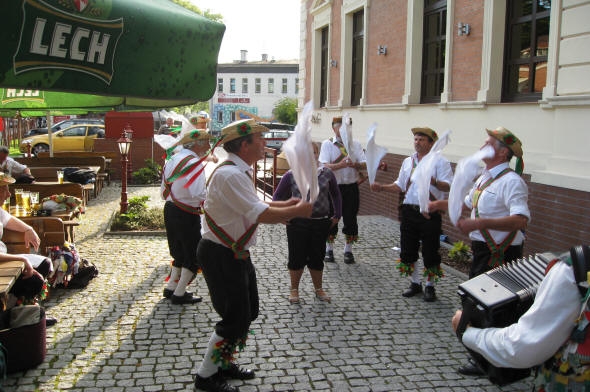 Handkerchief Balancing in Chojna
©2009 Jim Gailer
Handkerchief Balancing in Chojna
©2009 Jim Gailer
The Dorset Ooser
The side are the owners of the infamous Dorset Ooser (or Oozer), the new one that is, a
giant of a creature with a large wooden head and even larger horns, carved from
a passing log by John Byfleet using a small pen-knife. It is cloaked in the hide
of a peripatetic calf, supported on a stick, and ceremonially embedded in the
groin of a Wessex Morris Man. Poor old
David Chiplen always draws the short straw when it comes to carrying the Ooser,
something to do with the fact he is the only bloke big enough and strong enough
to lift it. Other people have tried on numerous occasions and ended up with
bleeding sores on their shoulders, even David has a rough time of it and has to
stop and rest at regular intervals. This is the main reason the Ooser is only
seen on May day and St. Georges Day. It is said, by some, to be the Dorset
manifestation of the Horned God; also known as Herne the Hunter, Cerne,
Cernnunos, etc. The newer version was made by John Byfleet in 1973 and can be
seen at The Dorset County Museum in Dorchester. In 2018 a more lightweight version
was made and this may be seen on the home page. If you want to see this Ooser in
action you will have to get up very early on May day and meet us at the top of
the Cerne Giant before sunrise.
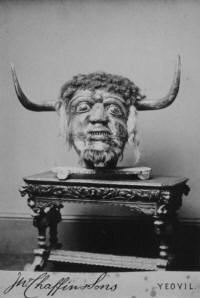 An old Ooser
An old Ooser
The original Dorset Ooser, (as seen in this photo from between 1883 and 1891
by J.W.Chaffins and Sons of Yeovil), was last seen in a Doctor Cave's loft in
Crewkerne around 1935 and is reported to have been sold by Doctor Cave's servant
to a stranger from East Chinnock, but in a very sorry state of repair. The horns
had fallen off and woodworm had made the mask very fragile. It is now the
popular opinion that, if it still exists at all, it has decayed to such an
extent that it will be unrecognizable. If you would like to
read more, read The Dorset Ooser, by Daniel Patrick Quinn
(reproduced by permission), or you can visit the Ooser himself in the
Dorset County Museum in
Dorchester.

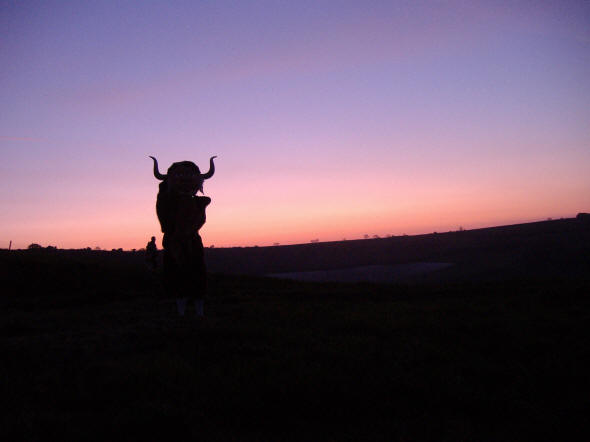 Spooky or what? The Ooser at sunrise, Mayday 2007
©2009 Tony Frost
Spooky or what? The Ooser at sunrise, Mayday 2007
©2009 Tony Frost
The Horse
Our horse is called Cadbury. A very engaging personality as you can see from the
picture. Horses and other animals have traditionally formed part of the morris
entertainment. Cadbury doesn't always come out with us.
In 1966, Don Byfleet (a recent foreman, of fond memory) and Heather Byfleet were invited to join the South
West Dancers touring folk festivals in France. As Don was part of the Sword
and Morris teams, he decided that an animal would add colour and realism to
the performance. A wooden horse was decided on. He therefore made a wire
frame and constructed a horse's head thereon using mainly plaster of paris
bandage. Hair, ping-pong eyeballs and a long skirt were added and the mouth
was fashioned to be opened and closed by the operator in the skirt. What
colour should it be? Don furkled around in his garage and found a half used
tin of paint the colour of chocolate. The side's squire at that time lived in the
village of North Cadbury, near Yeovil. Hence the Wessex hobby horse
"Cadbury" was born.
The plaster of paris proved unstable and began to crack and fall apart, so
the mascot was re-modelled in papier maché. Repaired, refurbished and
repainted over the years, Cadbury still survives to amuse the crowds today.

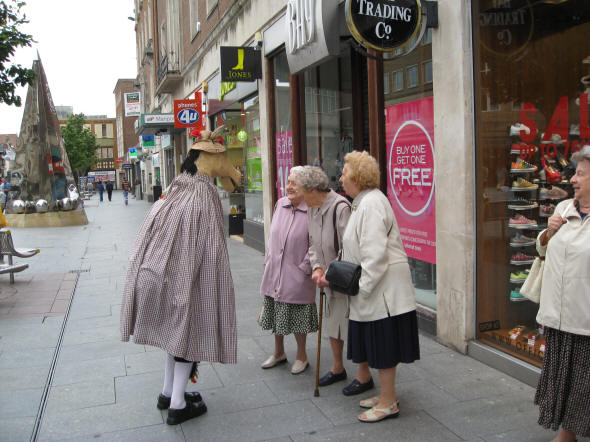 Edna was very worried that Cadbury has only two legs
©2009 Jim Gailer
Edna was very worried that Cadbury has only two legs
©2009 Jim Gailer
The Fool
The fool is supposed to be the best dancer in the side, keep the men in
order, act as a go-between with the audience and should really be an upright,
sensible and sober sort of a person. Anyway, you can see an example of what we used to have, below.

Dance Repertoire
Wessex Morris Men dance mainly in the Cotswold traditions of
Adderbury, Bampton, Bledington, Brackley, Ducklington, Fieldtown, Headington and
Litchfield and a couple of border dances, the Upton on Severn stick dance being
one of them. We also have our own specialty fertility stick dance from Cerne
Abbas: the Giant, which was devised by Don Byfleet. It is best viewed from
above when the full impact of the dance can be observed, (something to do with the
large pair of scissors that the Giant carries. Ladies of a sensitive disposition be warned.)
More...

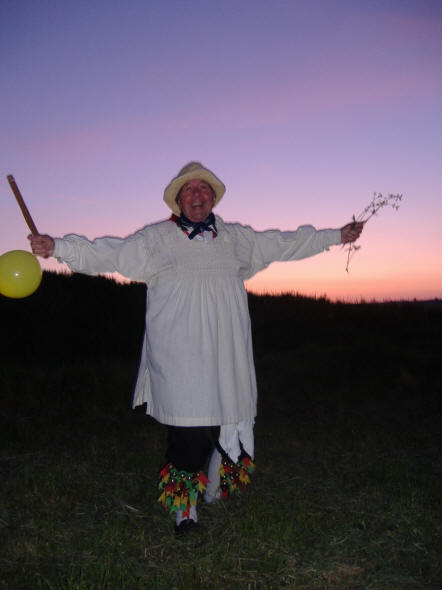 The Fool on the Hill
©2009 Tony Frost
The Fool on the Hill
©2009 Tony Frost
The Mumming Play
Mummers' plays have been performed in England since the late 1700s and most
Dorset villages would have had their own play. It is very likely that there was
a play in Cerne Abbas but, unfortunately, all traces of it have been lost, so
Wessex Morris have "imported" a play from Quidhampton, near Salisbury.
Nevertheless, since our play has been performed regularly in Cerne Abbas for
over thirty years... we now consider it to be "traditional" to Cerne.
Like all Southern English plays, the Cerne play involves a series of fights
between Saint George and his various adversaries, followed by a revival of the
slain combatants by a comic doctor and a concluding song and collection.
At our Christmas Party, at the Halsey Arms, Pulham, we also perform the play.
A few years ago, we unexpectedly found ourselves in the news
when the Dorset County Council were informed by some public spirited person, that
we were going to perform in the Red Lion and the New Inn. The pubs were called by
the Council and told that: if we performed our play, then they would be in breach
of licensing laws and would be prosecuted. Not to be outdone, we performed our play
in the street. With a few amendments to the dialogue that is, i.e.. out goes I, King
George instead of in comes I King George etc. All in all, this caused quite a
stir, with articles being written in the
Dorset Echo and other newspapers. This was at a time when the Government
intended to introduce changes to the licensing laws in the following July. Had the new law
not been changed, we would not have been allowed to dance, sing or perform
our plays without special licenses, effectively pricing ourselves and our
friendly landlords out of the folk business. Fortunately a petition was accepted
by the Lords, who amended the act, to the benefit of Mummers and Morris Men
everywhere.
You can see the script of the play
here
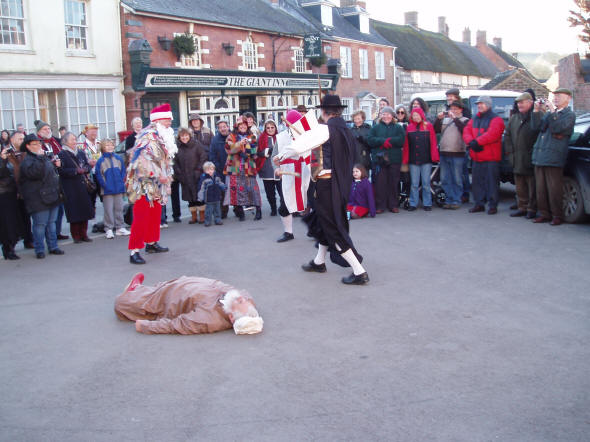 Wessex mummers at Cerne Abbas, Boxing Day 2008
©2009 Pete Robson
Wessex mummers at Cerne Abbas, Boxing Day 2008
©2009 Pete Robson
